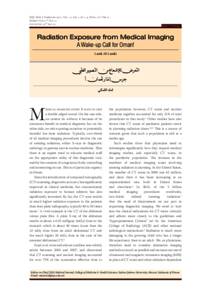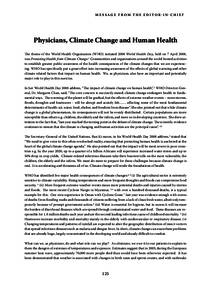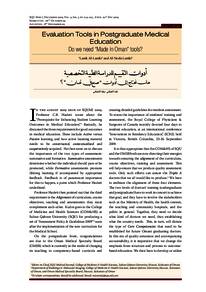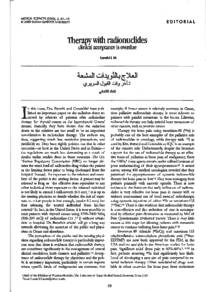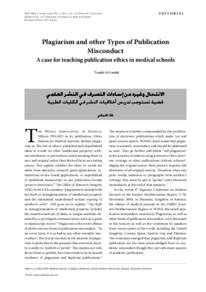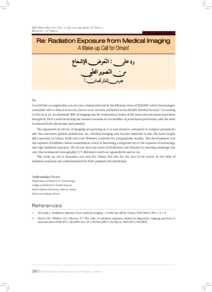Document
Radiation exposure from medical imaging : a wake-up call for Oman!.
Other titles
التعرض للإشعاع من التصوير الطبي : جرس إنذار لعمان!
Publisher
College of Medicine, Sultan Qaboos University.
Gregorian
2011-02
Language
English
English abstract
Medical imaging using X-rays is like a double-edged sword. On the one side, we cannot do without it because of its enormous benefit in medical diagnosis, but on the other side, we risk exposing ourselves to potentially harmful low-dose radiation. Typically, two-thirds of all medical imaging procedures involve the use of ionising radiation, either X-rays in diagnostic radiology or gamma rays in nuclear medicine. Thus there is an urgent need to educate medical staff on the appropriate utility of this diagnostic tool, and for the creation of a regulatory body controlling and monitoring its use. This is of particular urgency in Oman. What we need in Oman now is education of medical doctors on the dangers of medical imaging that utilises ionising radiation, in particular CT scanning and cardiac catheterisation studies. We also need continuing medical education on the appropriate criteria and clinical indications for the uses of these diagnostic tools. Most importantly, and perhaps of great urgency, is the creation of an independent regulatory body to regulate the safe use of ionising regulation in medicine and otherwise. This governmental body needs to be free of the control of any ministry, and has to have authority to license the use of radioactive materials and of X-ray-producing equipment, as well as regulatory control over the education of staff handling both low and higher dose radiation sources in medicine and elsewhere. We need to respect and control lowdose radiation to safeguard ourselves and our future generations.
Member of
Resource URL
Citation
Al-Lamkiyah, Lamk (2011). Radiation Exposure from Medical Imaging : A Wake-up Call for Oman!. Sultan Qaboos University Medical Journal, 11 (1), 1–4.
Arabic abstract
التصوير الطبي بالأشعة السينية يشبه سيف ذو حدين. من ناحية ، لا يمكننا الاستغناء عنها بسبب فائدتها الهائلة في التشخيص الطبي ، ولكن من ناحية أخرى ، فإننا نجازف بتعريض أنفسنا لجرعات منخفضة من الإشعاع قد تكون ضارة. عادةً ما ينطوي ثلثا جميع إجراءات التصوير الطبي على استخدام الإشعاع المؤين ، إما الأشعة السينية في الأشعة التشخيصية أو أشعة جاما في الطب النووي. وبالتالي ، هناك حاجة ملحة لتثقيف الطاقم الطبي حول الفائدة المناسبة لهذه الأداة التشخيصية ، وإنشاء هيئة تنظيمية لمراقبة ومراقبة استخدامها. هذا أمر ملح بشكل خاص في عمان. ما نحتاجه في عمان الآن هو تثقيف الأطباء حول مخاطر التصوير الطبي الذي يستخدم الإشعاع المؤين ، لا سيما التصوير المقطعي المحوسب ودراسات القسطرة القلبية. نحتاج أيضًا إلى التعليم الطبي المستمر حول المعايير المناسبة والمؤشرات السريرية لاستخدامات أدوات التشخيص هذه. والأهم من ذلك ، وربما يكون من الأمور الملحة للغاية ، هو إنشاء هيئة تنظيمية مستقلة لتنظيم الاستخدام الآمن للتنظيم المؤين في الطب وغير ذلك. يجب أن تكون هذه الهيئة الحكومية خالية من سيطرة أي وزارة ، ويجب أن تتمتع بسلطة ترخيص استخدام المواد المشعة ومعدات إنتاج الأشعة السينية ، فضلاً عن الرقابة التنظيمية على تعليم الموظفين الذين يتعاملون مع كل من المستوى المنخفض والعالي. جرعة مصادر الإشعاع في الطب وأماكن أخرى. نحن بحاجة إلى احترام جرعة منخفضة من الإشعاع والتحكم فيها لحماية أنفسنا وأجيالنا القادمة.
Category
Journal articles

